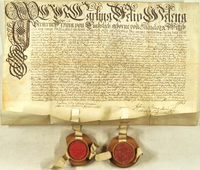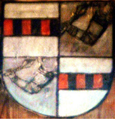Grimming (noble family)
The Grimminger (also known as Gryming , Grüming , Grimming or von Grimming ) were wealthy trades in Mauterndorf . The early Grimming were not fundamentally subordinate , but had their goods on baggage . A Grimminger was first mentioned in 1430 when Hans Grimming received a fiefdom from the Archbishop of Salzburg, Johann II von Reisberg, opposite Mauterndorf Castle . The family was counted early on to the Salzburg nobility and received the Salzburg Landmannschaft in 1528 . Lorenz Hübner counted her in the third class of the domestic nobility in 1796, "the country people, who are actually patricians and enjoy certain privileges and freedoms."
history
The Gröbendorf residence was owned by the Grimmingers in the 15th and 16th centuries. In the city of Salzburg they owned the Müllegg Castle they had built . Kaspar Grimming built Niederrain Castle in the 16th century . Between 1600 and 1717 the Grimmingers also owned the so-called Grimming Castle in Tamsweg .
In 1582, Hans Karl Grimming zu Niederain, caretaker and district judge in the Gastein, also owned Klammstein Castle ; likewise his son Alexander Grimming zu Niederain, who owned Klammstein from 1597 and also took over the district court in Gasteiner from his father. In 1604 he married the widow of Christof Weitmoser , Elenore Veronika Freiin von Spaur and Valor. In 1606 he became a nurse in Moosham .
At the beginning of the 17th century, the castle farm in Salzburg was owned by Georg Ludwig Grimming. This was followed by Ludwig von Grimming zu Neudegg.
Veith Balthasar von Grimming was a member of the Carinthian Landmannschaft as well as city governor and kit master of Klagenfurt . His brother was the imperial captain Georg Ulrich. Both were from Emperor Ferdinand III. In 1649 raised to the status of hereditary baron with the predicate of steel .
As was customary, the Grimming were related to other noble families in Salzburg: A Ludwig Grimming von Niederrain was married to Helena Rehlingen , Anna Maria Grimming von Niederrain (* 1631, † 1651) had Ludwig Franz Freiherr von Rehlingen (* 1619, † August 4, 1684) married, Alexander Grimming zu Niederrain, princely councilor and main caretaker in Hohensalzburg was married to Sophie Überacker . On January 31, 1692, Rudolph von Grimming died in Durach , to whom the founding of the pilgrimage sites Maria Plain and Maria Trost go back. He was the son of Argula von Eckher von Kapfing , (married von Grimming ) from Schloss Train and the caretaker at Schloss Fürsteneck , Johann Ludwig von Grimming von Niederrain .
The widowed Baroness Carlina Felix Helena Perger von Emslieb , b. von Mendoza, sold in 1695 as guardian for her grandchildren, the four children of her deceased son-in-law, of Hoftruchsessen Johann Christoph Griming zum Niderrain, on Müllegg, and her daughter Maria Angelina Griming, nee. Perger von Emslieb, namely Johann Friedrich Christoph, Johann Gottlieb, Johann Ferdinand and Maria Catharina Griming zum Niderrain, with the support of their cousin, the court councilor, colonel and bodyguard lieutenant Johann Ludwig Griming zum Niderrain, on Müllegg, the aristocratic seat of Archbishop Johann Ernst von Salzburg Müllegg and its accessories for 6000 florins and 100 ducats on loan.
In the 18th century, Adelstetten Castle went to a Grimminger for a short time . In 1753, Johann Josef Gottlieb Grimming von Niederrain and Herr zu Emslieb were named as the owner of Tandalier Castle .
The hereditary baron status was confirmed in 1756 to the chamberlain, court chamber councilor and administrator of Landsberg, Johann Gottfried Grimming von Stahl. The rent clerk at St. Gilgen , Joseph Freiherr Grimming von Stahl, on Adelstetten , was enrolled in Bavaria in 1813 when Salzburg was occupied by Bavaria and was a Salzburg and Styrian Carinthian lord and farmer . He was married since 1818 with the Baroness Anna von Lützelburg (* 1797), daughter of the Baron born Joseph of Lützelburg and Anna from Reiggersperg.
coat of arms
Grimming coat of arms at Goldegg Castle (around 1536)
Coat of arms of the Grimming on Hohensalzburg Fortress
The coat of arms from 1649 is quartered and covered with a silver heart shield , in it three red stakes, covered by a black bar ( family coat of arms ), 1 and 4 in gold, an armored arm, holding a mace , 2 and 3 divided diagonally , above in black a growing golden griffin , below red and single. Three helmets : on the right with blue and gold covers the arm with the pusikan, on the middle one with black and silver covers an open flight (family coat of arms) marked like the heart shield , on the left with black and gold covers the growing griffin.
literature
- Genealogisches Handbuch des Adels , Adelslexikon Volume IV, Volume 67 of the complete series, CA Starke Verlag , Limburg (Lahn) 1978, pp. 260-261, ISSN 0435-2408
- Moritz Maria von Weittenhiller : J. Siebmacher's large and general book of arms , Volume IV, Section 6 The Salzburg nobility , Bauer & Raspe, Nuremberg 1883
- Johann Kirnbauer von Erzstätt : J. Siebmacher's large and general book of arms , Volume IV, Section 4, Part 1 The Lower Austrian Landstands Adel , Bauer & Raspe, Nuremberg 1918
- Moritz Maria von Weittenhiller, Johann Baptist Witting , Otto Titan von Hefner : J. Siebmacher's large and general book of arms , volume 28. The arms of the nobility in Salzburg, Styria and Tyrol , Neustadt an der Aisch 1979
Individual evidence
- ↑ Johann Siebmacher, 1979, p. 20.
- ↑ Ernst Klebel , Gewachsene Eliten, in: Zeitschrift für Ganzheitsforschung , New Series, 5th Volume, Vienna IV / 1961, pp. 144–156, here especially p. 153 ( digitized version ( Memento des original from May 12, 2014 in the Internet Archive ) Info: The archive link was inserted automatically and has not yet been checked. Please check the original and archive link according to the instructions and then remove this note. )
- ↑ Wilfried Loecker, Mauterndorf im Mittelalter (accessed on May 11, 2014)
- ^ Lorenz Hübner , Description of the Archbishopric and Imperial Duchy of Salzburg , Volume 3, 1796, p. 891
- ↑ Klammstein Castle on dickemauern.de ( Memento of the original from May 5, 2014 in the Internet Archive ) Info: The archive link has been inserted automatically and has not yet been checked. Please check the original and archive link according to the instructions and then remove this notice.
- ^ Parish registry Durach , death registry, vol. II, p. 2 .: »31. January 1692. Prænobilis dominus Rudolphus de Griming omnem mundanam dignitatem et divitias spernens et solis elemosynis sponte oblatis vivens omibus sacramentis provisus obdormivit in domino. « (» January 31, 1692. The noble Lord Rudoph von Grimming passed away with all the sacraments He despised worldly honor and wealth. He lived on alms given voluntarily. " Quoted from: Margot Luda / Franz Xaver Greß: Wallfahrtskirche Maria Trost near Nesselwang in Allgäu , Anton H. Konrad Verlag: Weißenhorn 1986, p. 4 and note p. 22.
- ^ Monthly sheet of the Heraldisch-Genealogischen Verein "Adler" , Volume 4, 1896 ( digitized version )




